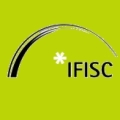


We propose a model of viral extinction which accounts for the effects of spatial competition when the infection propagates in a two dimensional Petri plaque. The model is inspired in the experimental evidence obtained by studying lethal mutagenesis, where the diffusion of mutants makes the plaque formed by dead cells grow at the contour of the plaque. Viruses can replicate themselves according to their fitness (mean number of offsprings per generation and genome), which will be assumed discrete up to a maximum value F. The process begins when a virion starts replicating on a cell, and mutates according to two different rates: deleterious (fitness decreases) and beneficial (fitness increases). The probability for a virion to infect a healthy cell is the fourth parameter of the model. We have modelled the propagation at the contour as a stochastic, one-dimensional cellular automaton that evolves according to some biologically relevant local rules which are simple functions of the probability rates. We have shown that this model belongs to the universality class of directed percolation, and have computed numerically the phase transition between the inactive (extinct) and active (percolating) phases. Besides, we have obtained several analytical approximations to the transition line. The most remarkable result we obtain from our study is an increase of the average fitness just before the extinction takes place.